In Plain Light 02.18 – The Words Issue:
Photography Definitions
Welcome to this month's newsletter!
In this issue: photography definitions from A to Z! Jump to a letter if looking for something special, or scroll down to read all definitions one after another.
A B C D E F G I M N P S V Z
You may want to rotate your phone in order to improve your browsing experience on this site.
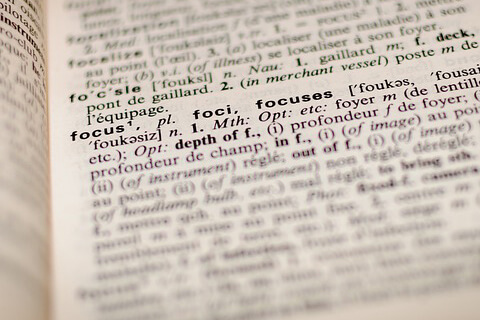
Photography isn't exactly a science, but even so, it is rooted in one. With this, and its strong technology links to boot, it is no surprise that it comes with a whole bank of its own terms.
These photography definitions is what we are going to explore in this issue.
Some of them are explained in more detail in dedicated articles within the tutorial and the Tips section. There are direct links to these pages all over the text.
Essential photography definitions
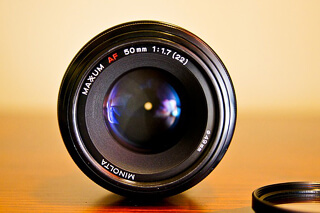 Lens naming its entire aperture range
Lens naming its entire aperture rangeAperture. Of camera settings responsible for exposure, aperture is probably the most confusing one. This is effectively the measure for the amount of light reaching the lens, expressed as the equivalent of lens's opening in relation to its focal length.
This is also how it is denoted as such: f/8 stands for an aperture of some lens opened to the diameter equal one-eighth its focal length.
This definition lets understand why long lenses with large apertures are so rare and expensive. A 400 mm lens endowed with f/2 would need to somehow embed the entire focal length, and then open to the diameter of 20 cm, or 8". This means rather a lot of glass.
Confusing is that this notation varies in lens specifications, descriptions and reviews. You would find the same aperture value also referred to as 1:8, f8, or simply 8. The two latter spellings are particularly misleading, as they make incomprehensible why a larger number, say 16, would describe a smaller aperture.
Note that this perfectly makes sense when aperture is presented as a fraction.
The maximum aperture of a lens is always present in its denomination. The larger this maximum aperture is, the faster the lens is considered.
APS-C is an image sensor format equal in size to the legacy film Advanced Photo System type-C, approximately 25.1 x 16.7 mm.
 APS logo
APS logoAPS had been introduced in 1996 as the last significant development in film photography before digital came to replace it. The smaller frame sized at 30.2 x 16.7 mm allowed for three fixed image dimensions. The full APS frame, or APS-H, could be cropped at wish to "classic" APS-C or "panoramic" APS-P, 30.2 x 9.5 mm, when being developed.
The APS-C frame is about 3 times smaller than the 35-mm "full-frame" format and makes smaller and lighter cameras possible. Due to it, lenses also require smaller focal lengths to achieve the same spatial coverage, and thus can be reduced in size, too.
The dimensional factor of 1.5 applies without change to the focal length. An 18 mm APS-C lens has about the same coverage as a 28 mm full-format lens. Conversely, this latter lens will have the coverage of a 42 mm lens when attached to an APS-C camera.
Bayer filter and Bayer image sensor. Although literally at the heart of digital photography as we know it, the term and its definition are hardly known and rarely discussed, if at all.
Unlike colour film, which consists of several emulsion layers sensitive to different light wave lengths and hence colours, the vast majority of image sensors in digital chips have only one layer. As a consequence, light-sensitive elements in sensor cells are unable to record the complete colour information in the light reaching them.
Instead, each sensor cell selectively measures the intensity of one dedicated colour channel conducted to it through a filter. The entirety of these filters builds a mosaic pattern whose Bayer variety is the most common one.
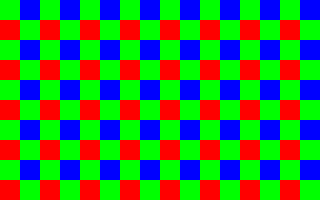 Bayer matrix
Bayer matrixThis is how a typical digital sensor sees the world. Green cells dominate with 50% of the lot, while red and blue cells make the rest with 25% each. The recorded information in every colour channel is patchy and needs interpolation [read: an educated guess] to calculate missing fragments from the values in their neighbouring cells.
In the image above, each cell only knows the value of its assigned colour component for sure. Green cells have a particularly hard time to tell their real colour, with only two cells of each other kind to help them out.
A true full-colour alternative to Bayer sensors is offered by Sigma with their Foveon chips. A notable workaround for conventional sensors has been developed by Ricoh for their high-end Pentax K camera models (see Pixel Shift Resolution).
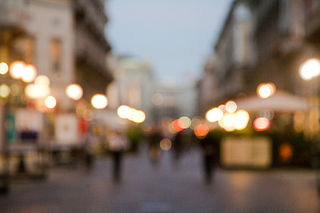 Bokeh example
Bokeh exampleImage by E. Bergamini, via Wikimedia Commons
Bokeh. The Japanese word stands for the aesthetic quality of the blur created by a specific lens in out-of-focus image areas. Pronounce BOH-kay.
While being of little significance for landscapes, this lens characteristic is quite important for portrait and wildlife photography. The effect can be very irritating when handled badly by the lens, and it can't be easily recovered in post-processing.
I like to think of this as a genuine example of virtual reality, not present in real life and only "dreamed" by the lens.
Centre-weighted metering. This metering mode concentrates on readings at the frame centre, which account for 60-80% of the exposure outcome, with areas around the edges given much less significance.
Composition. The idea of composition isn't exclusive to photography. The concept is known and studied by all visual arts, and its principles are followed—or should be considered, to the very least—by all visual artists.
Composition defines the internal structure of an art object—be it a painting, a sculpture, a graffito, a drama stage, or a photography image—and the relations between its constituting parts. In a photograph, these include the main subject and secondary ones, the fore- and background, negative space, lines and patterns, colours, and how all of it works together—or fails to do that.
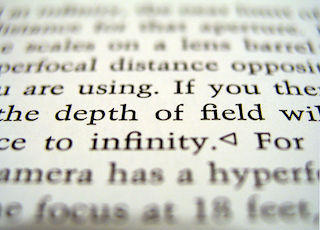 Shallow depth of field example
Shallow depth of field exampleImage by Ligar, via Wikimedia Commons
Depth of field defines the boundaries within which the image remains sharp. Long lenses and large apertures turn out images with the shallow depth of field, while short lenses and small apertures bring most picture areas in focus.
When working with wide-angle lenses, landscape photographers' ability to reduce depth of field is very limited—down from f/5.6 pretty much everything will appear sharp in the final image.
Many modern cameras will provide some kind of depth of field preview while composing and focusing.

Distortion. Distortion with regard to a photographic lens defines the latter's inability to render straight lines as such. A square grid photographed with the lens prone to distortion will feature patterns rather resembling a barrel or a cushion.
EV, or exposure value, is the measure and the unit of the amount of light used to create a photographic image. The absolute numbers are of scientific interest only, if at all, but the relative ones are readily used by professional photographers and advanced amateurs alike to compare different exposures in many a context.
The EV arithmetic is something to keep an eye on when changing exposure settings. To achieve the same exposure value, eventual tweaks should be counterbalanced by modifying other exposure parameters.
For example, opening up aperture by 1 f-stop (+2 EV) would also require, say, halving both exposure time and ISO (-1 EV each).
Since the underlying scale is logarithmic, the difference of 1 EV is equivalent to doubling or halving the amount of light in question. Underexposing by 0.5 EV, i.e., the difference of -0.5 EV, means reducing the amount of light reaching the sensor by √2, or around 1.4 times.
Exposure. The definition can describe a single shot, like in "I just took two exposures to have the job done", as well as the process of light metering, like in "Lighting conditions made the exact exposure extremely difficult".
In any case, the definition involves setting aperture, shutter speed, and ISO to create a photographic image. The correct exposure, though not the only contribution to a successful picture, is still an indispensable one.
Exposure compensation is the result of human judgement in the evaluation of one's camera's attempts at exposure—feel free to replace "human" and "one's" with "your". If you are not convinced by the results at hand, or expect current lighting conditions to fool your camera, step in and under- or overexpose deliberately. Most cameras nowadays will allow manual compensation at least from -2 to +2 EV in 1/2 or 1/3 EV steps.
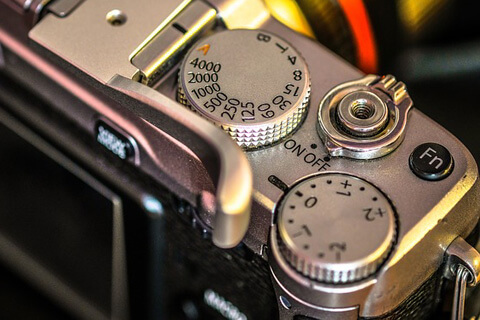 Shutter speed and exposure compensation wheels
Shutter speed and exposure compensation wheelsFixed focus. Don't confuse this with fixed focal length, they are quite different ideas. Fixed-focus lenses cannot adjust their pre-installed focus which, usually combined with a small aperture, will render anything from several meters to infinity sharp.
Fixed-focus lenses are in use by disposable and low-end cameras, in phones, webcams, and surveillance cameras, where high image quality is often not a priority.
Focal length. In optics, the focal length of a lens is a measure of how strongly the lens converges or diverges light.
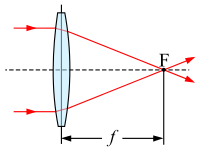 Focus and focal length
Focus and focal lengthby Henrik, via Wikimedia Commons
It is the distance over which parallel rays [from a source in the infinity, like with most landscapes] are brought to the focus. The shorter this distance, the wider is the lens's angle of view.
Though modern lenses consist of several optical elements grouped together, the principle is still the same. Short lenses with wide angle of view are best fit for landscapes, while long, or telephoto, lenses are especially good for portraits or wildlife photography.
The short range usually ends at 35mm, and the long range starts at 85mm. Within these limits lies the standard range.
Focusing is the process of adjusting the camera lens in a manner to render some parts of the image sharp while blurring its other parts.
For objects close to the camera, this process actually involves moving the lens inside its body in order to get a specific scene plane rendered exactly in the lens's focal plane [which coincides with the sensor or film position].
If left to the camera itself, that is, to autofocus, what you get is what your camera thinks you are trying to achieve. The most straightforward approach in deciphering your intentions results in focusing on objects near the image centre. Fancier methods also consider faces within the frame, or particularly bright objects.
If you want/need full control over your camera, learn its handling of manual focus.
Foveon X3 sensor. This alternative to Bayer sensors is currently offered by Sigma in their cameras. These chips consist of three separate layers, each dedicated to its own colour channel, just like the film of yore. This approach records the complete colour information, but leads to a reduced resolution in every single layer and problems in low light, very film-like.
YouTube channel by Martynko
"Golden hour". The usual definition limits this to a short period of time just after sunrise or before sunset, when the light changes to warm and soft pink-orange-golden hues. These qualities, however, apply to the low-standing sun, not any particular time. If the weather is right, it is perfectly possible to enjoy the golden hour nearly all day long in late fall and winter.
ISO stands for "International Organization for Standardization" (Macmillan: "an organization that deals with agreements about units of measurement and the meanings of technical words"). Its use in photography relates to medium sensitivity standards, or, in general, to film and sensor sensitivity. In particular, it defines setting the latter when calculating exposure for an image.
While higher ISO values still tend to increase digital noise in the resulting images, the effect gets more and more contained by the year in advanced camera models. Reasonable results at ISO 25600 are not unheard of anymore.
Matrix, or multi-zone metering. This is the default, and the most common metering mode of many a camera.
With it enabled, the camera would use lighting information coming from several (many) predefined points throughout the frame and average this information according to some algorithm in its software.
Alternatives to this approach are centre-weighted and spot metering.
Metering mode. The mode defines which area of the frame is taken into account and evaluated when the camera calculates exposure. Refer to matrix, spot, and centre-weighted metering for examples. A dedicated article describes several other metering modes as well.
Negative space. The concept of negative space plays an important role in image composition, especially in landscape photography. The idea denotes open areas in the picture frame not occupied by subjects, like the sky, open water, or a large, empty plane.
When executed right, landscape images with much negative space can be very evocative and emotional.
Panoramic camera. Cameras capable of recording images with the aspect ratio of 2:1 or more [without cropping] are considered panoramic cameras. The first panoramic sensor is still to be announced, but some futuristic, and even more legacy—vintage?—models are already/still around. Follow the link to find out more.
Pixel Shift Resolution. This method to record full colour in a Bayer-sensor-equipped camera has been developed by Ricoh for their Pentax-branded cameras [since K-3 Mark II]. The technology involves taking four subsequent exposures of the same scene, with the sensor matrix offset by 1 pixel each time, then combining the information from different colour channel readings in-camera. The newest flagship, K-1 Mark II was announced on February 22, 2018, with availability for April 2018.
YouTube channel by pentaxplus
(Open the [silent] clip in full-screen and see it in HD in order to follow the comparison.)
Shutter speed. No speed at all, shutter speed actually defines exposure time, i.e., the time during which the shutter of your camera will stay open to let the light reach whichever sensitive medium sits behind it.
You can use longer exposure times, or, if you will, slower shutter speeds, to blur moving objects or features, such as water or clouds, in the resulting picture.
Spot metering. A very exact metering mode evaluating only a small area of the image, about 1-5%. Some cameras will allow to freely position the spot within the frame, while others will require to recompose after taking the reading off the very centre.
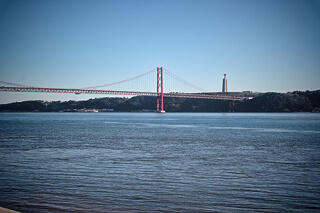 Vignetting example in a landscape image
Vignetting example in a landscape imageVignetting. The term attributed to a lens describes the visible light fall-off in its corners. Depending on motif, it might look fitting, for example, to add an extra vintage feeling to a black-and-white picture. However, more often than not, it simply reveals a poor lens in the hands of a lazy owner—the effect can be undone without much effort in Photoshop or other image editors.
Zoom vs. prime lenses. Lenses with a single, fixed focal length are called prime, while those with an adjustable focal length within a range are zoom lenses.
Zoom is more convenient, especially when travelling, since you don't need to change lenses often, if at all. However, all-in-one lenses with a huge zoom range usually underperform with regard to image quality, in particular, near the edges of their length bracket.
📷
Didn't find what you were looking for? Ask below! Leave a comment, and I'll add the missing part—consider this work in progress.
Useless knowledge: Don't shoot
Ever wondered why photographers' speak is so rich in words with negative connotations? It never stops to amuse me.
We try to catch the moment, chase the light and the motif, then expose to take, capture, and shoot images, as if they were targets, and every successful one a kill.
As if every photo outing were a safari.
As if we were on the prowl.
The most popular French photo magazine for the last over 40 years is called Chasseur d'Images, "Picture hunter".
Why is that?
“A great photograph is a full expression of what one feels about what is being photographed in the deepest sense, and is, thereby, a true expression of what one feels about life in its entirety.”
Ansel Adams
Can it be a hunt trophy?
Stop shooting—start creating.
Bonus track
It's all about wordsTags: #inplainlight #photographyspeak #comingtoterms #bydefinition
Unattributed images on this page are sourced from public domain via Pixabay and Wikimedia Commons.
Photography definitions explained in detail
- Camera exposure and its elements
- Understanding camera exposure principles and settings, including exposure compensation, bracketing, and manual exposure.
- Aperture and depth of field
- Learn what aperture is and how its different settings can change the look of your images.
- Shutter speed and motion blur
- Learn how exposure time can add dynamic and movement to your images.
- ISO and digital noise
- Learn how photo noise is related to your chosen ISO value.
- Metering modes
- Understand different metering modes and when to use them.
- Exposure compensation and bracketing
- Learn how to overcome shortcomings of your camera's automatic exposure metering.
- The sunny 16 rule and manual exposure
- Measure up to your camera and take exposure in your own hands with this simple and easy to follow rule.
- Photography composition
- Composition is ultimately what your photography stands or falls with. Even with the exposure nailed down, if your images don't engage the viewer, nobody will bother. Read here what matters in order to succeed.
- Panoramic cameras
- Ever wanted to try one? Here are your current options!
- Choosing a camera lens
- Everything you need to know when looking for a new camera lens, in one place: manufacturers, mounts, formats, types, and how to understand all those mystic lens labels.
- Understanding digital camera lenses – and their reviews
- Understand how to tell good digital camera lenses from the rest when reading their reviews.
Other resources
- Foveon image sensor
- If you are curious about this very different sensor, pay a visit to the camera manufacturer who uses it. While at it, take a look at their sample image gallery and some real life shots. The latter are also available at another location. (Images presented are downsized JPEGs—compression may have done some damage to them.)
- Pentax K-1 series site
- Learn how to obtain full colour information with a ubiquitous Bayer sensor, and what else the brand has to offer.
Previous issue
- 01.18 – The 2017 review issue
- 2017 is over but not yet forgotten. To make it stay this way a bit longer, find here the year in review—through archived blog entries.
Following issue
- 03.18 – The weather issue: How to forecast weather
- For those who enjoy—or suffer—planning ahead. Learn how a small Swiss company manages to forecast weather in every place in the world just by studying their own forecasts from the past, why this works, and how you can benefit from their results.
Tell me what you think!
Is it useful 👍? Awful 👎? Leave a message! Your comments help make this site better (and give me a kick—one way or another).
Popular articles
-
A kind of magic
If a digital picture has to be seen in the real world, printed on a real medium and displayed in a real showcase, its transition from RAW to real is better done in an old school image editor. Enter A…
-
A duck for a dog
If you got your own place on the Internet, helping your visitors find what they are looking for is a great way to engage them and keep them staying a bit longer. A custom site search can achieve just …
-
"Might as well have the best"
Aiming for better images? Think better lenses! This is your most important piece of gear, so you better get it sorted out. — Need some advice?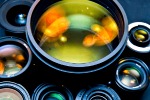
 Become a patron for
Become a patron for